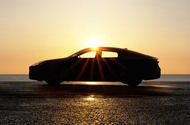The Lexus ES: A Bold Step Towards Electric Reinvention
The automotive landscape is undergoing a significant transformation, with electric vehicles (EVs) taking center stage. Among the brands navigating this shift, Lexus is poised to make a striking impression with the upcoming eighth-generation ES saloon. Set to be unveiled at the Shanghai Motor Show, this new iteration aims to compete directly with established players like the BMW i5 and Audi A6 E-tron. But what does this mean for Lexus, its customers, and the broader market?
Understanding the Shift to Electric Power
For the first time, the Lexus ES will offer electric power options, marking a pivotal moment for the brand. This transition is not merely a response to market trends; it reflects a strategic realignment within Lexus as it seeks to establish itself as a leader in the luxury EV segment. The ES is being positioned as a “global flagship model,” indicating its importance in Lexus’s lineup and its potential to attract a wider audience.
The decision to introduce electric variants, including the trademarked ES 350e and ES 500e, suggests that Lexus is not just dipping its toes into the EV waters but is ready to dive in. The ES 350e is expected to feature a single motor with a range that could surpass the current offerings in the segment, while the dual-motor ES 500e is likely to deliver impressive performance metrics. This commitment to electrification is crucial, especially as the automotive industry increasingly prioritizes sustainability and efficiency.
The ES’s Role in Lexus’s Lineup
Historically, the Lexus ES has been a more fleet-focused model, performing better in markets like the UK compared to its larger counterpart, the LS. The LS has been dropped from the UK lineup due to disappointing sales, leaving the ES as the sole saloon offering. In 2023, the ES recorded nearly 2,000 sales in the UK, a notable achievement given the competitive landscape dominated by models like the BMW 5 Series and Mercedes-Benz E-Class.
This shift in focus raises questions about the future of the LS and highlights the ES’s growing significance within the brand. As Lexus pivots towards electrification, the ES could become a cornerstone of its strategy, appealing not only to individual buyers but also to fleet operators looking for efficient, eco-friendly vehicles.
Design and Performance: A New Era for the ES
The design of the new ES is expected to reflect a modern, aerodynamic aesthetic, with a low-slung silhouette that enhances both style and efficiency. Lexus has made significant strides in improving aerodynamic performance, which is crucial for maximizing range in electric vehicles. The emphasis on sleek design aligns with consumer preferences for vehicles that are not only functional but also visually appealing.
In terms of performance, the ES is likely to inherit technology from the Lexus RZ crossover, which has already demonstrated impressive capabilities. The RZ 350e, for instance, features a 77kWh battery that delivers a range of 357 miles, while the RZ 500e offers a dual-motor setup with 376bhp. If the ES can build on these specifications, it could redefine expectations in the luxury saloon segment.
Market Trends and Consumer Preferences
The timing of the ES’s debut in Shanghai is strategic, given the model’s popularity in China, where saloons remain a preferred choice among consumers. The ES has been the top imported car in China since 2017, reflecting a strong demand for luxury vehicles in this market. As Lexus seeks to expand its footprint in China, the new ES could play a crucial role in capturing the attention of affluent buyers looking for innovative, high-performance vehicles.
Moreover, the overall growth of Lexus imports into China, which saw a 4.1% increase last year, indicates a positive trend amidst a challenging global automotive market. This resilience underscores the brand’s potential to thrive in competitive environments, particularly as it embraces electrification.
Embracing the Future of Luxury Mobility
As the automotive industry continues to evolve, the introduction of the new Lexus ES marks a significant step towards a more sustainable future. By prioritizing electric power and innovative design, Lexus is not only responding to consumer demands but also setting a standard for luxury mobility. The upcoming Shanghai reveal promises to showcase a vehicle that embodies the brand’s commitment to excellence, performance, and environmental responsibility.
In conclusion, the eighth-generation Lexus ES is more than just a car; it represents a bold vision for the future of luxury vehicles. With its electric options and sleek design, the ES is poised to attract a new generation of drivers who value both performance and sustainability. As the automotive landscape shifts, Lexus’s commitment to innovation will be key in navigating the challenges and opportunities that lie ahead.

